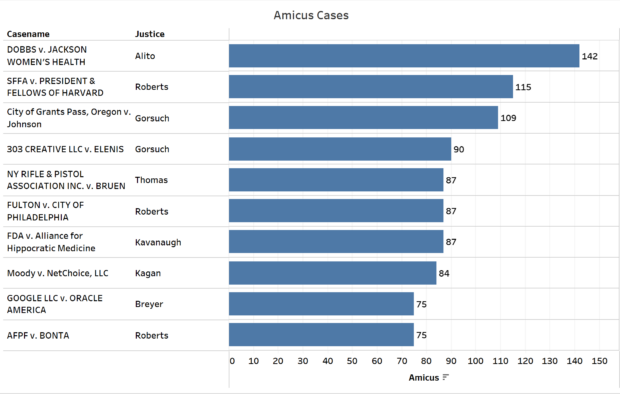 Chief Justice John Roberts heralded the significance of one of the biggest cases from last term, Trump v. United States, with the words,
Chief Justice John Roberts heralded the significance of one of the biggest cases from last term, Trump v. United States, with the words,
“This case poses a question of lasting significance: When may a former President be prosecuted for official acts taken during his Presidency? Our Nation has never before needed an answer. But in addressing that question today, unlike the political branches and the public at large, we cannot afford to fixate exclusively, or even primarily, on present exigencies.”
What is more important to our nation than the president? Should the president be treated differently than a common member of the public? And perhaps most relevant to the forthcoming election, can Trump be prosecuted for actions he took while President of the United States?

How Filevine’s New DraftAI Cuts Out Hours Of Writing Work
Now it transforms your document creation with natural language prompts.
Roberts synthesized this last point when he wrote, “This case is the first criminal prosecution in our Nation’s history of a former President for actions taken during his Presidency.”
The magnitude of this case is unassailable. Still, this was not the only important case the Court heard over the past year. Last term, the Court also heard cases relating to guns, abortion, the administrative state, January 6th, and more. The justices divide up these decisions and while Chief Justice Roberts assigns the majority opinion authorship in the vast majority of cases, generally the division is close to uniform across the justices.
With near equal opinion authorship counts among the justices, how do we know which opinions are more important than others and how do we tell which justice writes the most important opinions based on a metric that accounts for dozens of cases across multiple terms?
The Method

Why Your Practice Is Burning Money And How You Can Do Better
Our expert panel explores common sources of profit leakage along with practical steps for improvement.
In political science studies related to the United States Supreme Court, case importance is often referred to as case salience or political salience. The major work on political salience is from Lee Epstein and Jeffrey Segal and looks at whether cases were mentioned on the front page of the New York Times the day after the decision in a case was released. Works such as one by Clark, Lax, and Rice build out more complex quantitative ways to measure relative news coverage as a means to understand political salience of cases.
This article takes a different path to measure case importance. To construct a measure of case importance, this article seeks several different dimensions and looks for their convergence as a means to say when one case is more important than another case. When the aggregate of a set of cases is attributed to their majority authoring justices, we can say which justice writes the most important decisions.
Since the last major shift in the balance of the Court occurred with the vacancy left by Justice Ginsburg, and the nomination and confirmation of Justice Barrett in 2020, this is a reasonable place to start to get a sense of who writes the most important opinions on the current Court. Also, since Justice Breyer retired after Justice Barrett ascended to the Court, Justice Breyer and his replacement, Justice Jackson are treated as a combined single entity in this piece.
Back to the measurement, there are four angles which are used to show importance from different directions. Three of the measures distinguish between cases as they relate to the justices: total decision word count, number of separate opinions, and decisions by a small vote margin (either 5-4 or 6-3). These all show different types of case importance. The justices tend to write lengthier opinions when they see the need to bifurcate their opinions against challenges, and often to steep their opinions in the decisional history of the Court. When the justices write more separate opinions in a case, they generally have stronger independent views, which in turn showcases the importance of the cases to these justices. Multiple separate opinions are not necessarily in the Court’s lengthiest decisions though as some of the longest ones involve only a majority opinion and a strong dissent. This attribute of case importance is similarly captured in counting cases with close vote margins as these also tend to be ones where the justices articulate the strongest feelings regarding the Court’s final decisions.
The last measure is the count of amicus briefs filed in these cases. As interest groups that represent wide swaths of the public, along with private individuals and scholars, file amicus briefs, these also make up a good thermometer of the importance of cases to the public. As the data show, often the most widely discussed decisions also incur the largest number of amicus filings.
Once all of the cases are measured along these dimensions and the cases are attributed to the majority authoring justices, the justices are then ranked along these dimensions from one to nine with nine as the justice with the highest counts of each measure and one as the justice with the lowest. The additive measure of these four rankings creates the final score for each justice.
Case Breakdown
First let’s look at how the cases stack up. The two measures that provide the greatest spread between cases are amicus briefs and word counts. The following graph shows the top 10 decisions since the 2020 Term with the most associated amicus briefs along with the majority authoring justice for each case.

The first several cases including Dobbs (abortion) and SFFA (affirmative action) are clearly some of the most publicly discussed decisions of the Court. The importance of cases on this list though relates to a large variety of issues including free speech and copyright. The FDA (mifepristone) case is the only one of these ten decisions that did not create significant precedent that will ultimately impact the decisions from lower courts and consequently the general public.
Next, a look at the cases with the highest word counts.

Not surprisingly, many of the cases with the highest word counts also are ones with the largest number of amicus briefs. Aside from the top three cases though, several other cases on this list including Haaland v. Brackeen, the Trump case, and Loper Bright did not make it on to the list of the ten decisions with the most amicus briefs. One possible takeaway is that although there are several shared cases on the top of these lists, below the top they look at different aspects of case importance.
In terms of separate opinions, at the high end of signed decisions, several cases had a combined four concurrences and/or dissents including Trump v. United States and Bruen, but also United States v. Zubaydah, Erlinger v. United States, and Collins v. Yellen.
The Justices
For the next step, we start by adding the case counts based on the majority authoring justices so, for instance, Justice Thomas is associated with the total number of words based on total word count of all decisions he authored. Starting with word counts and looking at this measure based on each justice we see the following:

Looking at all of the signed decisions since the start of the 2020 Term, Chief Justice Roberts leads the pack by a large margin with 502,038 words. The rest of the justices bunch much closer together although Justice Gorsuch with the second most words has almost twice as many as Justice Sotomayor who is the last ranked justice according to this measure.
Next a look at amicus briefs:

Like the previous measure, Roberts leaves the rest of the justices well behind him as he has nearly twice as many associated amicus briefs as Justice Gorsuch who has the next most. Some of the cases attributed to Roberts include the SFFA affirmative action decision, Fulton v. Philadelphia, and AFPF v. Bonta. The order of the justices is nearly the same for these two measures with the only difference in order coming from Justices Kagan and Breyer-Jackson switching spots.
The next order is according to separate opinions filed in each case where a given justice authored the majority opinion.

While Justice Roberts is on top for this measure as well, there is a shakeup below Roberts with Justices Kagan and Thomas in places two and three. Justices Barrett and Sotomayor make up the bottom two for this measure as well.
Finally, a look at the justices who authored the most majority opinions in closely divided cases.

While there are several similarities between the order of the justices here and in some of the other graphs, Justice Alito drops a bit here and Justice Sotomayor rises a few positions with Justices Breyer-Jackson at the bottom.
While the justices mainly followed the norm of equal opinion authorship, there was somewhat of an unequal distribution with Chief Justice Roberts authoring 28 majority opinions across these terms while Justices Barrett and Alito authoring the fewest with 22 each. Just to make sure that the greater number of cases does not substantially change the results, the next graph shows the amicus and word counts for each justice normalized based on the number of majority opinions they authored.

The positions for the justices are nearly the same with Roberts far ahead of the other justices on both of these measures even though he also authored the most majority opinions of the justices.
How the Justices Rank
With all of the data organized by justice, the next step was ranking the justices according to their relative positions for each measure. This is shown in the table below:

Chief Justice Roberts easily writes the most important opinions according to these measures and he is far ahead of all of the other justices. Below him is a cluster of three more conservative members of the Court, Justices Alito, Kavanaugh, and Gorsuch. The second major cluster mixes conservative and progressive justices and includes Justices Kagan, Thomas, Breyer-Jackson, and Barrett leaving Justice Sotomayor on an island at the bottom.
With a 6-3 conservative majority in the current Court, it is not surprising that the top four justices according to this opinion importance measure are on the conservative end of the Court. The more interesting division is in the second cluster, where Justice Kagan is ahead of conservative justices Thomas and Barrett. Indeed, Justice Barrett, who is often touted as a impactful decision-maker on the Court still ranks next to the bottom in terms of writing the most important decisions. As the Justice often considered the farthest to the left on the current Court, Justice Sotomayor not surprisingly sits at the bottom of the aggregate ranking.
Near the end of the Trump v. United States majority opinion, Chief Justice Roberts describes,
“Our first President had such a perspective. In his Farewell Address, George Washington reminded the Nation that ‘a Government of as much vigour as is consistent with the perfect security of Liberty is indispensable….’ It is these enduring principles that guide our decision in this case. The President enjoys no immunity for his unofficial acts, and not everything the President does is official. The President is not above the law.”
As this writing suggests, Roberts often saves the most important decisions for himself.
* Data for this post came from the personally curated sources, the United States Supreme Court Database, and scotustext (from Jake Truscott). Cover image from Canva.
Adam Feldman runs the litigation consulting company Optimized Legal Solutions LLC. For more information write Adam at [email protected]. Find him on Twitter: @AdamSFeldman.